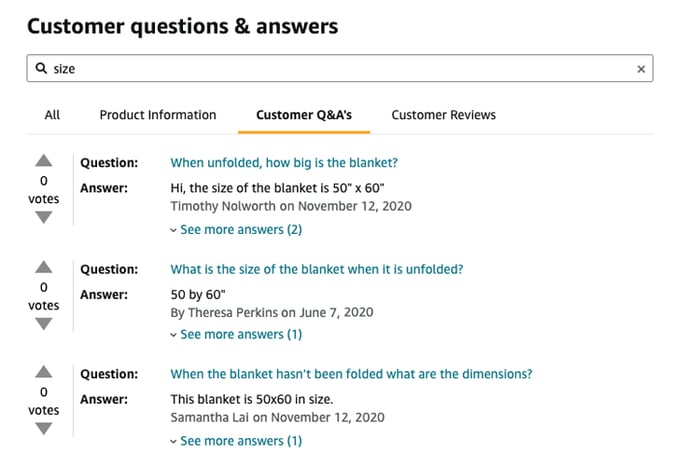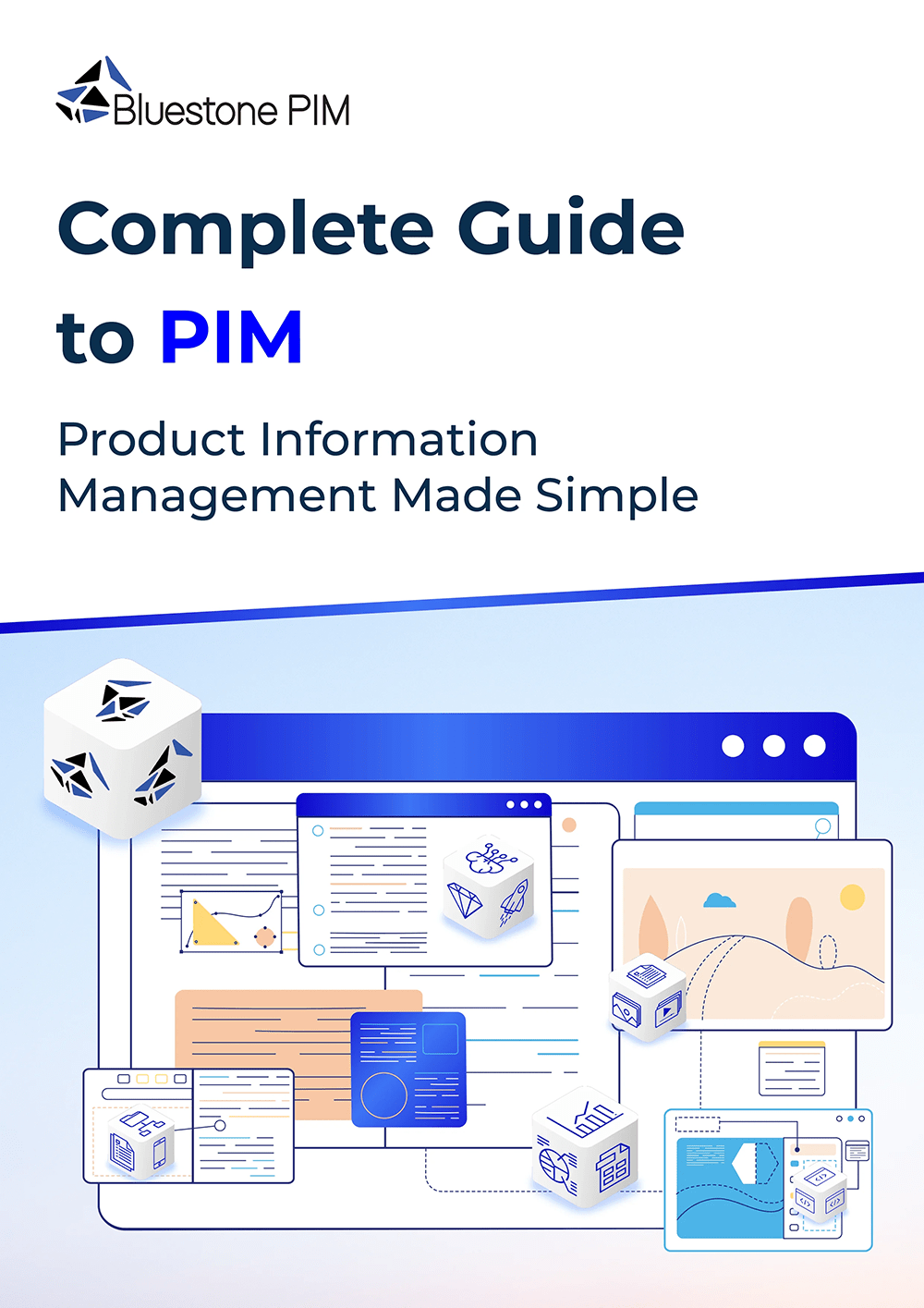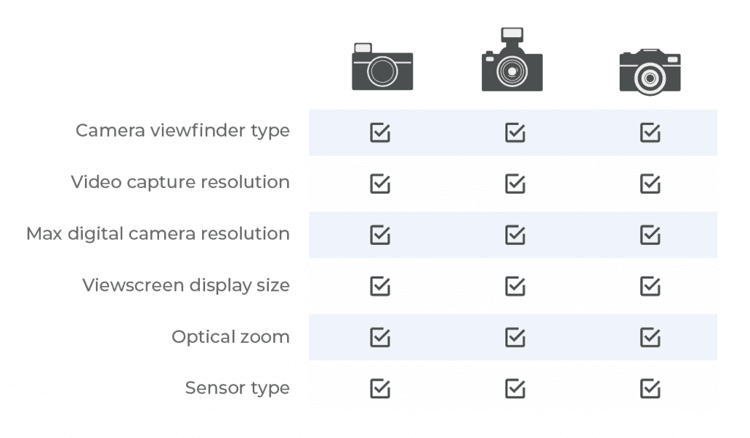How to Create Product Attributes That Sell

Shoppers want more than just basic features or specifications. They need to know what a product is made from, how it should be used, and how it compares to similar products and variants.
Providing rich product attribute information on your e-commerce product pages helps customers make informed decisions and increases conversion rates.
In this guide, you will learn:
-
What product attributes are
-
Why product attributes are essential for the customer experience
-
How to create and optimise product attributes that drive sales.
Here are the key fundamentals we ensure our Bluestone PIM customers have in place, plus proven strategies for creating product attributes that sell:
What Are Product Attributes?
Product attributes are characteristics or features that describe a product. These attributes can be physical, such as the size, shape, or color of the product, or they can be more abstract, such as the brand image, quality, or value.
Product attributes in a product feed serve a vital role: they distinguish each item from others in your catalogue and communicate the key features, benefits, and unique selling points to both customers and sales channels.
Managing thousands of SKUs in Ecommerce?
Get monthly tips to become the e-commerce pro your team needs.
What's The Purpose Of Attributes In The Product Feed?
-
Improve discoverability: Attributes such as size, colour, material, and brand make it easier for search engines and marketplace algorithms to surface your products to relevant shoppers.
-
Drive conversions: Clear, detailed attributes help customers quickly understand what makes each product unique, boosting confidence and purchase rates.
-
Enable precise filtering: On e-commerce sites and comparison platforms, attributes allow shoppers to filter, compare, and select products that meet their exact needs.
As the father of modern marketing, Philip Kotler, puts it:
Product attributes are the ingredients necessary for performing the product or service function sought by consumers.
A well-structured product feed with rich, accurate attributes is essential for:
-
Syndicating product data across multiple sales channels and marketplaces
-
Ensuring compatibility with Google Shopping, Amazon, and other platforms
-
Supporting flexible product data modelling in your PIM system, like Bluestone PIM

8 Hacks on Creating Product Attributes That Sell
Along with research and product information management, these 8 hacks are what you need to create helpful product attributes that you can easily manage:
1. Listen to Your Customers
First and foremost, no one understands the customers better than themselves.
You should make it a point to understand their wants and needs so that you can start communicating with them in their language.
You can achieve this by adopting a customer-centric approach!
Here are 4 tips you can start with:
-
Monitor customer reviews and feedback across all channels. Check what customers are saying about your products—and your competitors'—on social media, Google, and marketplaces. When customers ask questions, it's usually because they can't find the information they need on your product pages. Pay close attention to which product features they're asking about and how they describe them in their own words
- Track how customers interact with your product pages. Use tools like Hotjar to see where customers click, scroll, and spend time. This reveals which product attributes matter most to them.
- Listen to customer conversations online. Use social listening tools line Brandwatch or Meltwater to discover what people are actually saying about products in your category. You'll uncover which features customers care about most.
- Optimise for search with real customer language. Take the insights you've gathered about how customers describe your products and weave them into your SEO strategy.

If you have received numerous inquiries about the size of your blanket when unfolded, it is certain that the "unfolded size" attribute is important to your customers.
2. Run Conjoint Analysis
According to HubSpot, conjoint analysis is a market research method used to understand how people make choices. It presents people with realistic scenarios to find out what influences their buying decisions and what features matter most to them.
For example, conjoint analysis can help answer questions such as, ‘Would customers buy this product if it were launched?’ or ‘Which product features do our customers care about most?’
This approach helps marketers predict what customers are likely to buy by showing which product features are most important to them.
To carry out a conjoint analysis, list all the features of your product and decide who your target customers are. Then, create a survey and share it through your marketing channels, like email or social media.
3. Put Attributes in Groups
Grouping attributes will streamline product enrichment. When grouped, it is much easier to know where the missing pieces of information are.
Attributes should be grouped in your PIM system (Product Information Managment) according to their character or specificity, for example:
- Physical attributes (e.g., size dimensions)
- Technical attributes (e.g., water absorption or density)
- Marketing attributes (e.g., catalog description)
- Logistics attributes (e.g., packaging type)
- Others

DOWNLOAD FREE E-BOOK
Complete Guide to PIM
Ready to scale without drowning in product data? Discover how commerce leaders are using modern PIM to expand into new markets faster whilst improving customer experience.
4. Set Attribute Types
You can keep your product data accurate by setting the attribute type before you enter any values. This means the system will only let you add data in the correct format. For example, if you choose the Boolean type, you can only select ‘Yes’ or ‘No’—nothing else is allowed.
You are not limited to just text or numbers; there are many other attribute types you can choose from.
| Boolean | Input is Yes or No |
| Date | Input is selected with the use of a calendar feature |
| Decimal | Input is a number with a decimal. Sometimes minimum, maximum, and step values can be specified |
| Formatted Text | A type containing formatted text, allowing the customization of text, like bold type or italics, adding links, bullet or numbered lists, block quotes, and heading styles |
| Integer | Input is a whole number. Sometimes minimum, maximum, and step values can be specified |
| Location | Input is a combined value of latitude and longitude |
| Single Select | Input activates multiple options, but it is possible to select only one of them |
| Multi Select | Input activates multiple options, allowing selecting more than one of them |
| Multi Line | Input accepts text as multiple lines but its result is a line of text concatenation |
| Pattern | Input uses expressions to validate the content field to match a predefined format |

DOWNLOAD FREE E-BOOK
How Top Retailers Use AI: 7 Use Cases
Packed with real examples, practical tips, and the tools behind the strategies, this e-book is a must-read for retail and e-commerce leaders who want AI to really work for their business.
5. Create Category-Level Attributes
When working with large numbers of SKUs, you can’t fail to notice that products that belong to the same group or category will share attributes (but not the values of those attributes).
When you know that all items that fall into a specific category will be given the same set of attributes, you should assign the attributes not to individual products, but to the higher level in the structure, i.e., categories or catalogs.
Example 1: Car Tyres
You are a car accessories retailer. You know that all the products belonging to the ‘Tyre’ category must have the following attributes:
- Season (winter, summer, or all seasons)
- Load index (the maximum load each tyre is designed to carry)
- Speed index (the speed capability of a tyre)
You need these attribute values for each product in this category, but more importantly, you can’t publish even one product in this category without this input.
There are 2 options you can work with.
Option 1: Manually input this set of required attributes every time you introduce a new tyre to your shop, but this would be a waste of your time.
Option 2: Set a validation rule for the ‘Tyre’ category once and automatically apply those attributes to all products associated with the category. These are known as category-level attributes (CLAs).
It is obvious that Option 2 is the best way forward. It is simply so much faster and less tedious than Option 1!
The benefits of category-level attributes are as follows:
- Saves time that would be wasted on repetitive and mundane data entry work
- Safeguards against incomplete product information in your system
- Create high-quality and consistent product data
Example 2: Cameras
If you sell cameras, you know Nikon, Pentax, Olympus, and many other brands share the same attributes, like depth of field, shutter speed, and aperture.
So, what you should do is apply a category-level attribute structure template not only to Canon, and not only to other manufacturers but to the entire product category (digital cameras), of which Canon is only a subcategory.
Then you set the attributes to the category level, and have the subcategories inherit them.

Important tip
Turn your category tree into a classification tree by moving product attributes up to the highest possible level where they are still unique. This means you only need to add each attribute once to a category, and all products in that category will automatically have it. As a result, you will spend far less time updating individual products and avoid repeating the same work.
6. Create Compound Attributes
Some attributes typically combine multiple data.
For example, the dimensions of home decoration items, like curtains and blinds, are displayed in a combination of height and width. Not only is that the format that most customers expect to see, but it would also be inefficient to display these pieces of information separately.
This is where compound attributes (height x width x depth) come in handy. This pattern is particularly relevant, for example, for furniture or building materials manufacturers.
7. Restrict Access to Attributes
Managing product information involves at least a few groups, such as catalog admins, suppliers, or external agencies.
It is wise to create rules or policies specifying which attributes each of these groups is allowed to enrich. Decide who should be able to create, group, and view which attributes, or edit their types and values.
A fine-grained access policy will eliminate potential confusion over the responsibilities. Again, this is another measure to ensure you create high-quality data.
8. Implement a Comparison Tool on Your Product Page
If you have products with multiple technical specifications, consider implementing a comparison tool.
Follow best UX /UI practices, use smart filters and sorting options, use plain language in microscopy, and avoid using technical jargon that your customers probably wouldn't understand in your product descriptions.
Better yet, why not use Product Information Management software like Bluestone PIM to simplify your workload and accelerate your time-to-market?
It comes with all the features you need to enrich your product data and digital assets, monitor your product completeness, and discover process gaps that are holding your sales back.
Types of Product Attributes: Tangible vs. Intangible
Product attributes can be divided into two main categories: tangible attributes and intangible attributes.
Tangible Product Attributes
Tangible product attributes are the physical characteristics of a product that customers can identify using their senses. These attributes are quantifiable and measurable, making them easy to compare across different products.
Examples of tangible product attributes include:
-
Size and dimensions
-
Weight
-
Material composition
-
Colour and design
-
Taste or smell (for consumable goods)
-
Screen size or battery life (for electronics)
Intangible Product Attributes
Intangible product attributes refer to the non-physical qualities that influence a customer's perception and experience. These attributes are often subjective and based on personal feelings or opinions.
Examples of intangible product attributes include:
-
Brand image and reputation
-
Perceived quality
-
Aesthetics and style
-
Prestige or exclusivity
-
After-sales service and customer support
-
Emotional value
Features and benefits are two product attributes that are commonly included in a product description. But at the same time, they are also the most misunderstood and thus presented incorrectly.
Product features are an integral part of your product. They can describe the technical or functional aspects, and show what the product can do. Features remain the same across all variants of the same product and can't be sold as a separate product. If you can do so, then those "features" are attributes.
Product benefits are abstract and subjective, while product attributes are objective and specific. Benefits show how they can bring a positive impact on their users or their lives and make them better. For example, product benefits could be shock absorption in a shoe that protects your feet from injury, a vegan jacket that is environmentally friendly, or a luxurious bed that guarantees a good night's sleep.

So while features are the "facts" of the product, benefits are usually what attract customers and convince them to make the purchase. Both are equally important, and a great product description should lack neither of them.
After all, features tell and benefits sell.
Product Attributes Examples
Product attributes are objective properties that provide details about the product, such as quality or verification (e.g., "certified by" or "approved by"), marketing claims (e.g., "stain resistant" or "long-lasting"), logistics (e.g., package size or container), or innovations (e.g., new look or new feature).

Example of product attributes in Bluestone PIM
Here is a list of product attribute examples:
-
Name - The name of a product is a word or phrase that is used to identify and distinguish it from other products. It can also include the name of the brand or product line, and even the year of release. For example, the "Adidas Ultraboost 22" running shoes sold by Adidas.
-
Brand Name - Name of the company or manufacturer that produces the product. For example, the brand name of a popular clothing company might be "Levi's."
-
Stock Keeping Unit (SKU) - Unique identifier for a product. It is used for inventory management and can include information such as the product's name, size, and color. For example, an SKU for a t-shirt might be "TSHIRT-BLK-XL."
-
Size - Dimensions or capacity of the product. For example, the size of a bottle of shampoo might be 12 fl oz.
-
Color - The hue or shade of the product's appearance. For example, the color of a smartphone might be "Midnight Blue."
-
Design - The design of a product refers to its appearance and style. For example, the design of a new laptop might be "sleek and modern."
-
Price - The amount of money that it costs to purchase it. For example, the price of a new television might be $500.
-
Variants - Version of a product that differs from other versions in some way. Product variants can be created by changing the size, color, material, or other attributes of the product. For example, a clothing company might offer a t-shirt in multiple sizes and colors, resulting in multiple product variants.
-
Material Composition - Refers to the materials that the product is made of. For example, the material composition of a pair of shoes might be leather and synthetic.
-
Marketing statements - Messages or claims about a product that are used to promote or sell it. For example, a marketing statement for a new cleaning product might be "Our product is the most effective at removing stains!"
-
Lifestyle / in-context photographs - Images of a product that are taken in a natural or realistic setting, rather than in a studio. For example, a product page for a new camping tent might include photographs of the tent set up in a natural outdoor setting.
-
Video tutorials - Video resources that demonstrate how to use or set up a product. For example, a video tutorial for a new piece of software might show users how to navigate the interface and use various features.
-
Country of origin/manufacture - The country where a product is made or assembled. For example, a product might be made in China, the United States, or another country.
-
SEO components - Elements of a product's online presence that are used to improve its visibility and ranking in search engine results, such as keywords that describe the product and its features. For example, a product page for a new camera might include keywords such as "digital camera" and "high-resolution" in the meta description.
Ways to Use Product Attributes in Marketing
Product attributes are essential in marketing because they help customers understand what makes a product unique and valuable.
Product attributes include details like material, size, colour, technology, or sustainability features. When marketers highlight the right product attributes, they make it easier for shoppers to compare options and choose what best fits their needs. Here's how your team should use product attributes in marketing:
-
Images and Visuals:
-
Use lifestyle photos, 3D renderings, or videos as product attributes.
-
Visual attributes help customers imagine using the product.
-
-
Memorable Language:
-
Describe product attributes in creative ways.
-
Example: “A bed so soft it feels like you’re sleeping on a cloud.”
-
-
-
Feature Callouts:
-
Highlight key product attributes in bullet points or tables for quick scanning.
-
To select the most effective attributes, businesses should research what their customers value most.
This may involve analysing customer feedback, conducting surveys, or reviewing sales data to identify which product attributes drive buying decisions.
Why Are Product Attributes Important?
Product attributes are something that some retailers gloss over.
They might think it is fine if the product detail page is missing one or two (or even more) attributes. Surely customers can rely on the other given information to make a purchase decision, right?
Unfortunately, that is not the case.
Here are 3 reasons that highlight the importance of product attributes, and businesses that market or sell their products online should pay extra attention to them.
It Can Win or Lose Online Sales
It is predicted that retail e-commerce sales worldwide will increase from 2,982 billion U.S. dollars in 2025 to 5,211 billion U.S. dollars in 2027. This figure is forecast to grow by 50 percent over the next few years.
And as the numbers grow, so does the customer’s appetite for rich product information. After all, it’s the right product descriptions with the right product attributes that drive online sales.
 Worldwide eCommerce sales are predicted to reach 8.1 billion US dollars by 2026.
Worldwide eCommerce sales are predicted to reach 8.1 billion US dollars by 2026.
So by failing to include the information customers are looking for, you are losing potential sales and missing out on this surge in global eCommerce sales.
You may also be setting your customers up for disappointment when, after buying your product, they learn it doesn't look or function as expected, which consequently leads to unhappy customers, lousy reviews, and a high product return rate.
So by providing clear and concise product descriptions, you are one step closer to creating a great customer experience.
According to ROI research by Adobe, companies that focus on customer experience stand to see 1.9x higher retention rates, 2.1x higher customer lifetime value, and 1.7x higher revenue growth.
It Influences the Customer Decision-Making Process
It is without a doubt that product attributes are a critical factor for customers making a purchase decision.
They provide valuable information about the product, such as price, materials, and capabilities, and help customers make informed decisions about which product to purchase.
First off, product attributes help customers understand what a product is and what it does. For example, if a customer is looking for a new coffee machine, they might look for attributes such as size, brewing method, and coffee bean compatibility. By understanding these attributes, the customer can determine whether the product meets their needs, preferences, and budget.
Then by looking at the attributes of different products, customers can compare the features and benefits of each product and decide which one is the best fit for them.
This customer decision-making process is referred to as the product attributes decision. The quality of the product, its look, its features, and the way the features are combined determine the success of the product on the market.
We look for a product that is a combination of these factors, meets our needs, and is different in some way from its competitors.
It Is Part of the Brand Experience
There are at least a dozen definitions of a brand.
David Ogilvy, the "father of advertising”, considered attributes to be an essential part of a brand.
Brand is the intangible sum of a product’s attributes: its name, its packaging and price, its history, its reputation, and the way it is advertised
The brand experience starts when customers interact with the product features, benefits, and attributes. Then there is instant gratification and sentiment grows – positive sentiment remains or negative sentiment increases.
Attribute importance weights also depend on the perceived relative position of the brand.
A recent study by Sue Ryung Chang and Hyun Young Park, published in the European Study of Marketing, concluded that “consumers who perceive a brand as inferior to its competitors in a given attribute place greater weight on that attribute for that brand. In contrast, when the brand is superior in the eyes of consumers, the attributes don’t place greater weight on”.
Conclusion
Rich product information is a great commerce opportunity!
A 2018 study in e-commerce shows that users’ expectations grow, demanding highly precise and accurate product information.
Matt Janaway, CEO of Marketing Labs, couldn't have said it any better:
If you want to seriously growth-hack your eCommerce sales, stop all other marketing tasks and write some awesome product descriptions.
Merchants should align these general guidelines for product attributes with market-specific requirements.
While doing so, remember that there is an easier way to store and enrich product information than using spreadsheets (hint: use a Product Information Management system like Bluestone PIM!).
Hope you will not feel lost anymore. Do not be under any illusions that Vincent has made getting started with product attributes management a tedious chore!
Vincent: "What's with all these spreadsheets?!"

DOWNLOAD FREE E-BOOK
Leverage product information to turn visitors into customers
Everything you need to know about PIM before you buy it.
Working on the product attributes for your entire catalog with over 1000 SKUs isn't an easy task. That's where Bluestone PIM can help you simplify the way you work — by eliminating the need for manual data entry and saving you hours or even days of work and endless frustration.
Contact our advisors to learn how PIM can help you adopt a customer-centric approach to product attributes management or book a demo for a free guided product tour of Bluestone PIM.




